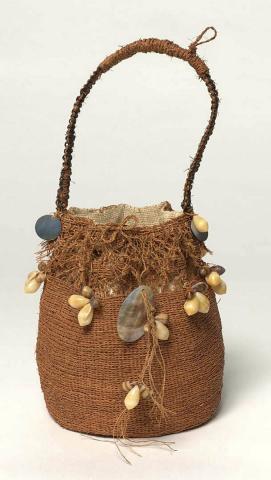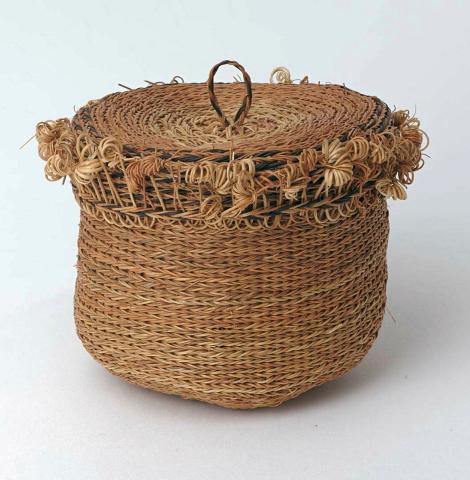Lesieli Tupou and Sione Maileseni at APT10
By Ruha Fifita
The 10th Asia Pacific Triennial of Contemporary Art September 2021
Weaving hair-like strands of coconut husk fibre by hand requires sharp eyesight, nimble fingers and much patience. In Tonga, coconut fibre is a highly regarded weaving material, valued both for the expertise required to work with it and the strength, durability and beauty of the finished woven objects. Lesieli Katokakala Tohi Tupou and Sione Maileseni are both distinguished coconut-fibre weavers from the islands of Tongatapu and Ha’apai. For APT10, the artists bring together a selection of recent works that draw on two distinctive forms of coconut-fibre weaving: the kato (bag/basket) mosikaka and the kato kafa. Although rarely made or used in Tongan society today, these forms feature meaningfully throughout its history.
Mosikaka is an ancient form of coconut-fibre weaving found only in Tonga. It is distinguished by a series of specific weaving patterns and techniques using the individual fibres from coconut husks. Historically, this method of weaving was practised by select individuals who worked solely for the royal family, and knowledge of the technique was exclusive to a small number of artists. Due to the complexity of the technique, a single basket would take months for a skilled weaver to complete. Mosikaka weavers produced highly durable, ornate baskets and containers used to hold precious items owned by — or gifted to — individuals of royal lineage. The extensive labour and secrecy that surrounded this practice gradually led to its decline, and when the last traditional masters passed away more than 200 years ago, the practice was discontinued.1
In 1968, Lesieli Tupou, a high school teacher at the time, led a number of students in a research project to study and learn the technique.2 Since then, she has continued to weave passionately and train others in the art form. The APT10 installation Ko e Koloa Lalanga mei he Kavele’ipulu: The Wealth of Coconut Fibre features eight of her most recent innovations, including two teki teki (ceremonial performance headdresses), a fan, a jewellery box and four kato. These works navigate between customary and contemporary signifiers of rank, wealth and hierarchy. The artist has extended the practice to ceremonial accessories and body adornment, while also creating forms that resemble more widely recognisable repositories of precious objects, including jewellery and holy bibles. The group of works collectively demonstrate Tupou’s remarkable ability to adapt the technique to a variety of shapes and find new flexibility of form, all the while clearly articulating her intention to explore new possibilities for the role this practice has in contemporary society.
Sione Maileseni was Tupou’s only male weaving student and has since distinguished himself through original woven works of exceptional scale and quality, which he has extended to wearable art and sculpture. For the APT10 installation, Sione has included three works that build on his experience with both mosikaka and kato kafa weaving techniques. Maileseni’s two kato kafa are made from thousands of delicate coconut fibres braided into kafa (sennit). The kafa is intricately woven around coiled coconut-frond midribs to form a robust ceremonial basket intended to hold offerings for high-ranking individuals. The larger kato kafa is titled Kato maeakafa toho, where the word toho implies that it is ‘grand’. At the centre of this installation is Sione’s own version of a pulupulu fakatu’i (imperial robe). Made completely out of kafa — and accompanied by a kahoa mosikaka (necklace) and fuekafa (chiefly fly whisk) — the exquisite garment gives expression to a vision of sovereignty that fully recognises and embraces the innate and distinctive strengths of a nation.
Through this combined installation, the artists offer their perspective on complex universal themes related to sovereignty and cultural resilience from the unique context of living in the last remaining, yet quickly evolving, Pacific monarchy. Sione Maileseni drafted the poem below in connection to these works:
Manatu (remember/pay tribute) … to our past and our ancestors.
Manatu … that our natural resources are biodegradable.
Manatu … that our work is our gift for our world and generations to come.
Manatu … that our artisanship holds our culture and traditions.
Manatu … that a strong maeakafa (coconut fibre rope) binds us together with the four pillars of the Tongan Culture.3
Endnotes
- Lesieli Tupou, ‘Mosikaka weaving’, The Encyclopedia of Crafts in WCC-Asia Pacific Region, April 2014, viewed May 2021.
- Lesieli Tupou, ‘Tonga: Traditional mosikaka weaving’, The Intangible Cultural Heritage Courier of Asia and the Pacific – ICH Courier, vol. 11, April 2012, p.7, viewed May 2021.
- Sione Maileseni, message to the author, 18 December 2019.
Connected objects

Kato maeakafa 2020
- MAILESENI, Sione - Creator

Efinanga ki he hau 2021
- MAILESENI, Sione - Creator

Fan c.2020
- TUPOU, Lesieli Katokakala Tohi - Creator
Metadata, copyright and sharing information
About this story
- Subject

